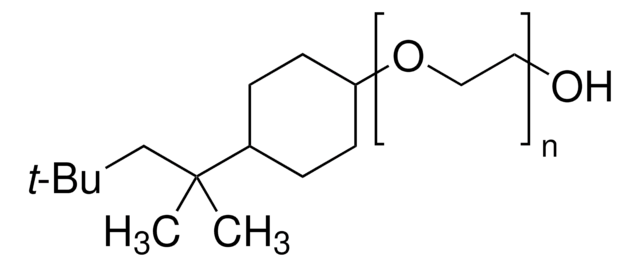282103
Triton™ X-100 reduced
Sinónimos:
Polyoxyethylene (10) isooctylcyclohexyl ether
About This Item
Productos recomendados
Quality Level
refractive index
n20/D 1.473 (lit.)
density
1.029 g/mL at 25 °C (lit.)
SMILES string
CC(C)(C)CC(C)(C)C1CCC(CC1)OCCOCCOCCOCCOCCOCCOCCO
InChI
1S/C28H56O8/c1-27(2,3)24-28(4,5)25-6-8-26(9-7-25)36-23-22-35-21-20-34-19-18-33-17-16-32-15-14-31-13-12-30-11-10-29/h25-26,29H,6-24H2,1-5H3
InChI key
QQJNBKDKLMCALZ-UHFFFAOYSA-N
¿Está buscando productos similares? Visita Guía de comparación de productos
General description
In biochemical and cell biology research, Triton™ X-100 is instrumental in solubilizing membrane-bound proteins and isolating lipid rafts. Its unique properties allow for the preservation of the native conformation of proteins obtained from cellular membranes in solution. Triton™ X-100 reduced is derived from the full hydrogenation of the benzene moiety of TX-100 to a cyclohexane derivative. This modified version, RTX-100, has demonstrated potential in enhancing enzyme digestion and influencing the photoisomerization of bacteriorhodopsin, showcasing its versatility and utility in advanced research applications.
Application
- as a component of LB-TT for the extraction of total protein from rat brains
- in ADP-Glo assay and Cytophos adenosine triphosphatase (ATPase) assay
- in phosphate-buffered saline (PBS) solution for the permeabilization of fibroblasts in 5′ ethynyl uridine staining, immunofluorescence, and immunolabeling
Features and Benefits
- Non-ionic surfactant
- Reduced polyoxyethylene content (~10)
- Improves solubility and dispersibility of substances
- Excellent wetting properties
- Enhances emulsification
- High purity product for research applications
Other Notes
Legal Information
comparable product
signalword
Warning
hcodes
Hazard Classifications
Aquatic Chronic 2 - Eye Irrit. 2 - Skin Irrit. 2 - STOT SE 3
target_organs
Respiratory system
Storage Class
10 - Combustible liquids
wgk_germany
WGK 3
flash_point_f
235.4 °F - closed cup
flash_point_c
113 °C - closed cup
ppe
Eyeshields, Gloves, type ABEK (EN14387) respirator filter
Elija entre una de las versiones más recientes:
¿Ya tiene este producto?
Encuentre la documentación para los productos que ha comprado recientemente en la Biblioteca de documentos.
Los clientes también vieron
Nuestro equipo de científicos tiene experiencia en todas las áreas de investigación: Ciencias de la vida, Ciencia de los materiales, Síntesis química, Cromatografía, Analítica y muchas otras.
Póngase en contacto con el Servicio técnico




